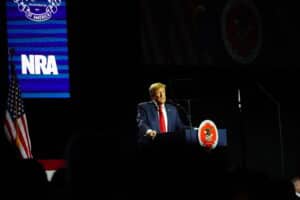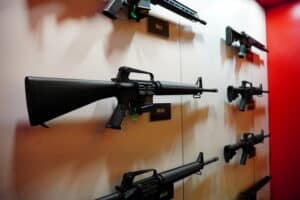I’m currently in Indianapolis, Indiana covering the NRA Annual Meeting.
I’ll have more reporting in the coming days but a few things are already apparent after the first two days. Trump spoke at the NRA’s Leadership Forum on Friday. He and the NRA are inexorably linked and their fortunes seem to be tracking with one another pretty closely at the moment. They both face serious legal issues in New York over accusations of corruption. They’ve both seen their political and public standing tarnished in the past few years.
But they’re both still formidable and even experiencing a bit of a resurgence at the moment. Despite being indicted on felony charges, Trump’s poll numbers in the primary are up (as he spent a significant chunk of his NRA speech bragging about). Despite losing over a million members in the last five years, the NRA managed to turn out noticeably more members to fill the seats at this year’s Trump speech than last (the crowd has been noticeably larger than last year throughout the meeting but still down from the last Indianapolis meeting in 2019).
Whether either can capitalize on the momentary bit of momentum and outrun their various legal and political problems remains to be seen.
The other big takeaway came during the NRA Meeting of Members, where it was clear the group’s internal fight is over. Wayne LaPierre won. He received a standing ovation from the room during his speech and, despite a sizable and vocal opposition, defeated a resolution calling for his resignation.
The NRA meeting is not the only news from this week. Contributing Writer Jake Fogleman also explains how new gun-carry restrictions passed in response to Bruen may end up backfiring. And I examine the hype around another “smart gun” primed to come to market this year to see whether it has a chance of catching on.
Also, I detail why “mass shooting” counts differ so much and why that matters.
Plus, The Violence Project’s James Densley joins the podcast to explain trends in mass shootings and potential solutions.
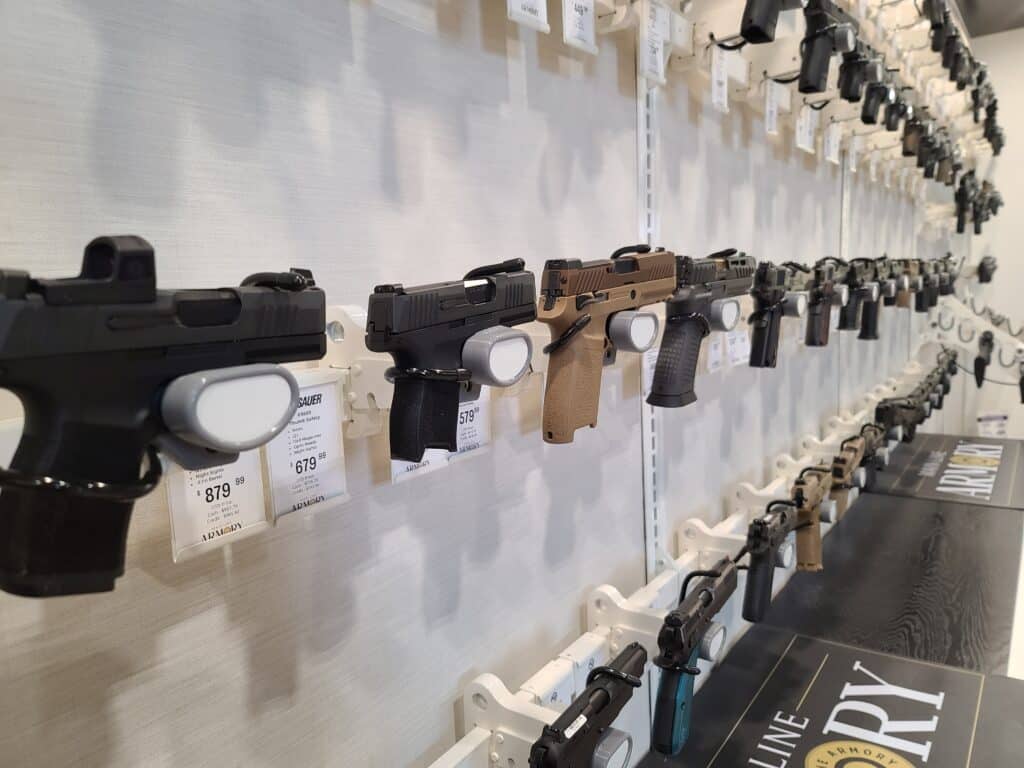
Analysis: Why Post-Bruen Gun-Carry Restrictions Might Backfire [Member Exclusive]
By Jake Fogleman
Formerly may-issue states continue to thumb their noses at the Supreme Court by passing some of the country’s most restrictive concealed carry laws. In doing so, they run the risk of undermining licensing schemes altogether.
Last Monday, Maryland became the third state impacted by the Supreme Court’s ruling in New York State Rifle and Pistol Association v. Bruen to pass a complete overhaul of its concealed carry laws. In a pair of bills, the state assembly greatly increased the application fees for new “wear and carry” permits, expanded its training requirements, and added new “sensitive places” throughout the state where licensed carry would be a crime. The off-limits areas include almost all publicly-accessible private property, like stores or restaurants.
The bills followed a familiar blueprint already established by states like New York and New Jersey, who were the first two states to rebuke the Court with onerous new laws. Fellow affected states, Hawaii and California, appear poised to do the same.
But those states are tempting judicial fate with their replacement laws, as evidenced by the parameters laid out by Justice Thomas in his Bruen opinion. The early track record of legal challenges to New York and New Jersey’s carry laws, where there have thus far been at least five injunctions between the two, can also attest to that fact. But even aside from the constitutional issues, on a more practical level, establishing a political norm of using licensing regimes to make exercising gun rights as difficult as possible creates new skepticism over the very idea of licensing laws.
The Supreme Court went to great lengths in its Bruen opinion to make clear that it was not yet prepared to call into question the legitimacy of standard “shall-issue” licensing laws.
“To be clear, nothing in our analysis should be interpreted to suggest the unconstitutionality of the 43 States’ ‘shall-issue’ licensing regimes, under which ‘a general desire for self-defense is sufficient to obtain a [permit]’,” Justice Thomas wrote in his opinion. “Because these licensing regimes do not require applicants to show an atypical need for armed self-defense, they do not necessarily prevent ‘law-abiding, responsible citizens’ from exercising their Second Amendment right to public carry. Rather, it appears that these shall-issue regimes, which often require applicants to undergo a background check or pass a firearms safety course, are designed to ensure only that those bearing arms in the jurisdiction are, in fact, ‘law-abiding, responsible citizens.'”
This carve-out for “shall-issue” regimes was likely the result of a compromise done to mitigate political backlash and shore up support among justices. It remains unclear how “shall issue” permitting laws really fare when closely examined under the text and historical tradition test articulated later in the ruling.
Nevertheless, the American people currently are broadly in favor of that compromise. A November 2022 poll from Marquette University’s law school found that 64 percent of U.S. adults favor the New York State Rifle and Pistol Association v. Bruen ruling. Similarly, a separate Marquette poll found that 62 percent favor allowing the concealed carry of handguns with a permit or license required. Conversely, permitless carry laws routinely poll poorly despite their continued success in red states.
But that equilibrium, in which Americans broadly favor both concealed carry rights and licensing laws, could ultimately become upended if more and more states continue to make lawful carry all but impossible. If push comes to shove and one has to go, it’s more than likely that the American people (and the Supreme Court, which has tended to act only after public opinion on guns has shifted) will choose licensing laws.
The recent experience in North Carolina is a perfect example of this. For years, gun-rights advocates favored repealing the state’s permit-to-purchase law for handguns, but to no avail. Meanwhile, at least nationally, the policy continued to poll favorably among the public. However, following the COVID pandemic and a series of scandals involving local sheriffs delaying permit applications, enough political momentum was finally there to get the repeal bill through the legislature. Two years later, with improved majorities, Republican lawmakers were able to get the repeal into law after overriding a veto.
Legal rulings striking down many of these likely unconstitutional Bruen replacement laws may arrive before sentiment shifts enough to make a difference. But litigation often takes many years, and the Supreme Court has thus far shown an unwillingness to intervene in New York’s law despite its restrictions being the first enacted and arguably the most burdensome. Therefore, relief from the courts might not be in the offing for some time.
As permitless carry approaches a political wall in the near future, continued efforts by gun-control advocates to undermine workable permitting schemes elsewhere across the country risks shifting the Overton window toward more permissive gun-carry systems, whether among the general public or the courts.
Since gun-control advocates very much don’t want to see that happen, they may be forced in the near future to give up the push for restrictive “shall issue, may carry” licensing schemes.
Podcast: Mass Shooting Patterns and Potential Solutions With The Violence Project’s James Densley [Member Early Access]
By Stephen Gutowski
The beginning of the week featured another horrible mass shooting in America. This time at a bank in Louisville, Kentucky.
That’s why I wanted to bring on one of the leading experts currently studying mass shootings. Metro State University Professor James Densley is one of the co-founders of The Violence Project, which has the most detailed and comprehensive database of mass shootings dating back to 1966. He is also the co-author of the book by the same name that outlines potential real-world solutions to the phenomenon.
Professor Densley explained why he believes the count they use, which only includes public attacks where four or more people are killed for reasons unrelated to other criminal conduct, gives the most accurate understanding of mass shootings. He said it’s important to properly define terms when you’re attempting to seriously study a problem and identify trends so you can craft solutions.
He laid out some of the common patterns seen in the lives of mass shooters before they carry out their attacks. For instance, he said most shooters have a long history of abuse and trauma before they decide to do the unthinkable. And the shootings almost always follow an inciting incident that sends the shooter into a crisis state.
Densley argued that a potential attacker could be “off-ramped” at any point along that path, whether it’s after they first experience abuse or after they begin experiencing an inciting crisis. What’s necessary is for those who recognize the warning signs to step in and do something to help. And that resources to help are made available and known to those looking to carry out that kind of intervention.
But those aren’t the only interventions Densley believes are necessary. He said firearms restrictions of some kind should be part of the equation as well, especially for those showing warning signs they may be a threat to themselves or others. We go back and forth on why gun-rights advocates and gun owners are not as open to those ideas as Densley would like them to be.
Ultimately, Densley said he believes mass shootings are not an inevitability and can be prevented through action on the individual and societal level–even if not everyone agrees on every aspect of the solutions he proposes.
Plus, Contributing Writer Jake Fogleman and I discuss a new win in court for marijuana users who want to own guns.
You can listen to the show on your favorite podcasting app or by clicking here. Video of the episode is also available on our YouTube channel. As always, Reload Members get access on Sunday. Everyone else will be able to listen on Monday.
Come on the Podcast
One of the many perks of a Reload membership is the opportunity to appear on the podcast. We’ve had a lot of people on the show from all kinds of backgrounds. It’s one of my favorite segments since it gives us all a better insight into the community that makes this publication possible. If you want to come on the show, just reply to this email and let me know!
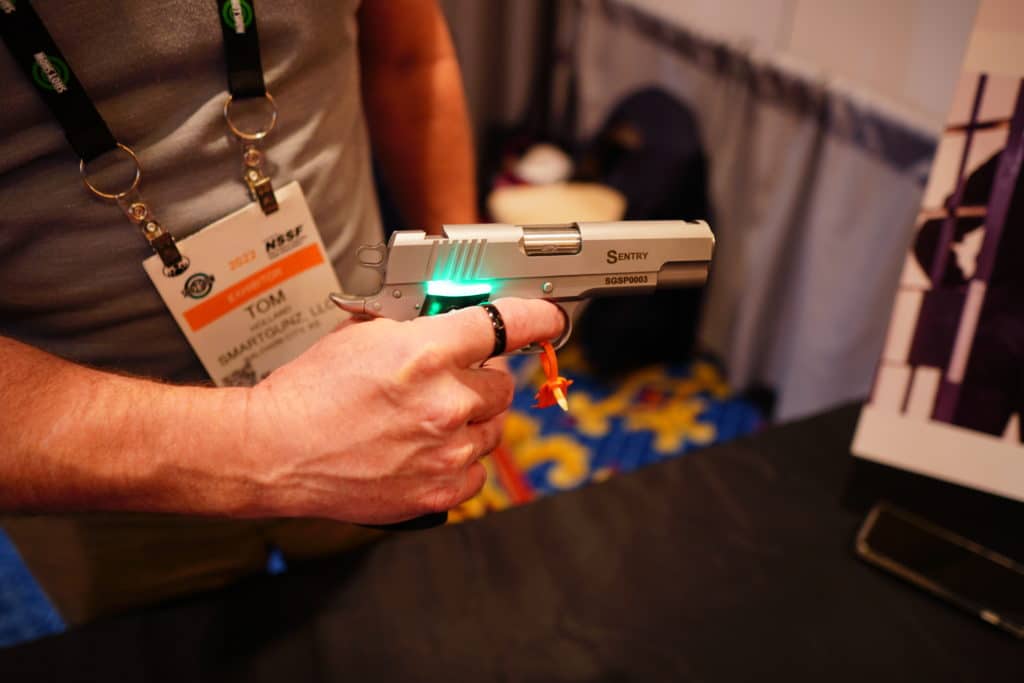
Analysis: Are ‘Smart Guns’ About to Change the Market? [Member Exclusive]
By Stephen Gutowski
The week saw another entrant in the race to bring a so-called smart gun to market.
On Thursday, Biofire announced a prototype handgun featuring integrated biometric locks. The company said it plans to start shipping guns to customers by the end of this year. But it isn’t alone in that goal because Smartgunz, a company that debuted a prototype at last year’s Shot Show, said it plans to start shipping its RFID-lock-integrated guns in the next few months.
So, it appears smart guns will soon be more than just a work of fiction. And the world will get to see how well they can compete in real life.
Because there haven’t been any public reviews of the Smartgunz 1911 at all. An incomplete prototype was on display last year. The company claims initial test models were shipped out to law enforcement partners in January. But there don’t appear to have been any public range days for it or public reviews yet.
Biofire has been a bit more open with its working prototypes. The company already invited the YouTube channels Forgotten Weapons, DutchInTheUSA, and a Bloomberg reporter to try it out. And it appears to be further along in development than any previous model.
It’ll have to be if it hopes to overcome the significant reliability concerns gun owners are bound to have about a gun with integrated electronic locks, especially one designed for home defense use.
After all, if you are betting your life on a gun, you need to know it will work each and every time you pull the trigger. Any potential failure point is a potential reason not to buy a gun. And gun enthusiasts can be very picky about these sorts of things.
Take the Series 80 1911 for example. That slight redesign by Colt incorporated a firing pin safety designed to prevent potential drop firing. The mechanical safety is relatively simple, made up of just four parts, but a substantial contingent refuses to buy 1911s that use this design.
Now, imagine adding a fingerprint sensor to that equation. Or a facial recognition camera. Or a specialized piece of RFID-embedded jewelry. Or a battery that needs to be kept charged.
On top of that, imagine building a new gun from the ground up around those features. So, you have to develop a novel firearm on top of developing novel security features. Adding even more complexity to the feat and probably explaining the multiple feeding issues on display in the Forgotten Weapons video.
Of course, that doesn’t mean there is no market for these guns. The Series 80 1911s are fairly popular despite some enthusiasts’ reservations. So are biometric safes that are susceptible to nearly all of the same shortfalls mentioned above.
There’s clearly a market for guns. There’s clearly a market for biometric safes to store those guns. There is likely a market for a gun with a biometric lock built into it, even if early models are as pricey as the Biofire (with the cheapest option coming in at $1,500).
But the reliability issues of integrating an electronic lock into a gun have never been the greatest impediment to their adoption. The tallest hurdle has always been distrust over how gun-control advocates and lawmakers will react to their introduction. And for good reason.
In 2002, New Jersey passed an infamous law mandating that three years after a smart gun is introduced to the market, those are the only kind of guns that could be sold in the state. President Joe Biden also vowed during his campaign to “put America on the path to ensuring that 100% of firearms sold in America are smart guns,” something almost certainly impossible without a ban on traditional firearms.
However, New Jersey’s law was reformed in 2019. It no longer bans the sale of traditional firearms when smart guns come onto the market. Instead, it requires they be sold alongside them. And President Biden hasn’t made any moves on smart guns since taking office.
That’s unlikely to put gun-rights advocates entirely at ease. But banning the sale of traditional firearms because of the existence of smart guns would also likely be unconstitutional under the Supreme Court’s Bruen standard for interpreting the Second Amendment.
And the position of gun-rights groups and the industry has long been that smart guns should be allowed on the market for those who want them. They just shouldn’t be the only option available since not everyone does want them.
But it appears we will soon begin to find out if enough Americans out there want a smart gun to support any of the companies now developing them.
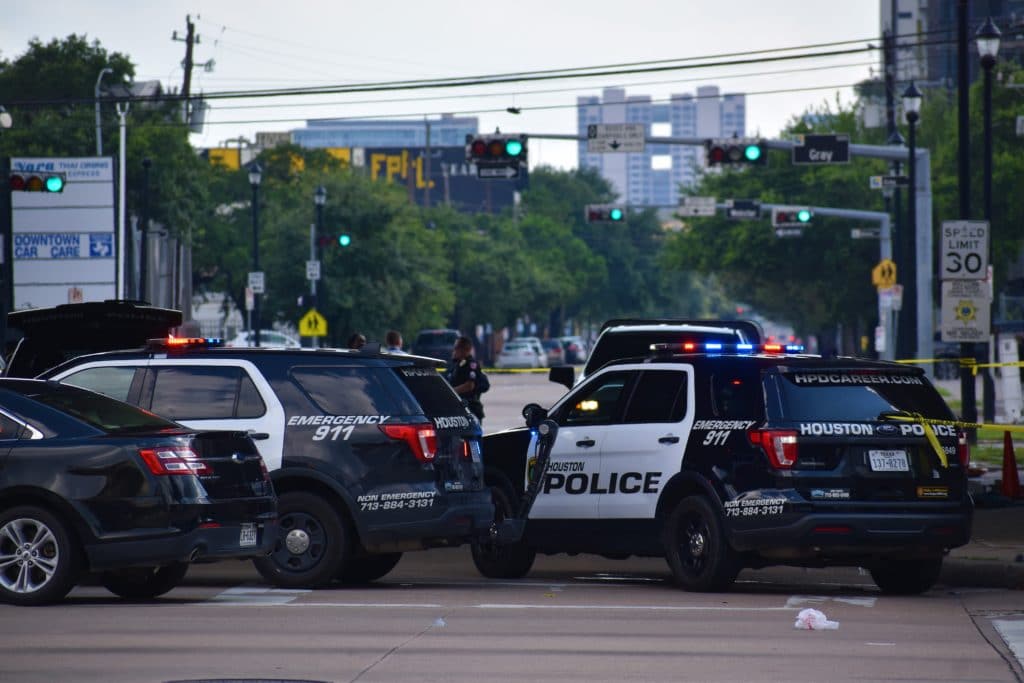
Analysis: Why ‘Mass Shooting’ Counts Vary So Wildly and Why it Matters
By Stephen Gutowski
Depending on what count you look at, Monday’s attack on a Louisville bank was either the 146th, 15th, or 4th mass shooting of 2023.
The huge variation in counts makes it very difficult to properly understand the scale of the issue. It creates confusion among the public and policymakers alike. But no official government definition of “mass shooting” exists, and the problem will likely persist for the foreseeable future, which is a good reason to understand the most prominent counts out there.
So, what are the different counts, and why do they vary so much?
The Violence Project (TVP) definition, derived from a 2015 Congressional Research Service report, includes events where four or more people are killed in public shootings, except those attributable to underlying criminal activity, such as robberies or gang fights. The USA Today/Associated Press/Northeastern University database counts any and all events where four or more people are killed (including with weapons other than firearms). The Gun Violence Archive (GVA) includes all events where four or more people are injured in a shooting.
There are more counts out there from The Washington Post, Mother Jones, and a few others that vary slightly. But the three above cover the primary methodologies that exist.
One clear commonality between those three definitions is the key marker for victims being four or more. That’s derived from the FBI’s generally accepted definition of “mass murder,” which sets the threshold of victims over a short period of time at four. The main difference between the lower counts from TVP and USA Today and the higher count from GVA is in whether just deaths should be included or also injuries. Is a “mass shooting” a mass murder committed with a gun or a mass attack with a gun?
Each approach has different strengths and weaknesses.
The main problem with the broader count is that it includes many shootings that many Americans wouldn’t think of as “mass shootings.” In fact, it’s likely the vast majority of the 146 attacks don’t resemble somewhat random attacks on groups of people in public by a lone gunman. Instead, many are crime-related incidents or gang shootings–critical issues to find solutions for, but not the same problem as something like Uvalde or Las Vegas.
The USA Today count suffers from a similar but less pronounced problem. It captures a phenomenon that’s sadly even more common in American society than randomized public killings: domestic murders. Most of the 15 events it chronicles are incidents where someone murders their entire family in their own home–another type of killing that’s important to find strategies to prevent, but still different from the attacks in Parkland or El Paso.
The TVP count, which is the most restrictive, does a better job of capturing the events most Americans would understand as “mass shootings.” It is a list of almost all the “mass shootings” that have received in-depth national media coverage. In addition to the Louisville bank attack, TVP’s count includes the two mass shootings experienced by Asian-American communities in California earlier this year and the murder of six people at a Christian school in Nashville late last month.
Of course, the restrictive nature of the TVP count has its own drawbacks. It only provides insight into mass shootings where the perpetrator actually accomplished their goal of killing many people. The FBI’s active shooter report suggests a number of people each year who attempt to carry out such an attack but are unsuccessful at killing many people for various reasons. Sometimes this means that shootings that look a lot like what people would think of as “mass shootings” and garner significant national attention, such as February’s deadly shooting at Michigan State University, don’t make the list because it doesn’t pass the grim milestone of four killed.
Still, The Violence Project is the best measure of how often someone successfully carries out one of these horrendous attacks. It also has data on every shooting that meets its criteria going back to 1966. That gives it a leg up on the other databases since USA Today‘s data begins in 2006, and GVA’s starts in 2013.
That helps provide a broader view of trends in mass shootings. The GVA number gets brought up a lot in media coverage because it’s large and has gotten much larger in recent years. But, since it tracks a much broader class of shootings and is likely correlating closer to overall gun violence, the fact that it only captures the last ten years likely doesn’t tell us much about long-term trends in mass shootings. It may well tell us that shootings and murders have increased recently, which seems to be the case.
But America has experienced a remarkable lull in violent crime and murder over the past two decades. The 1980s and 90s had far higher rates of violent crime and murder than the 2000s or 2010s. The early 2020s may be pushing us backward in this regard, but perhaps not as much as the GVA count of mass shootings would imply.
That doesn’t mean mass shootings aren’t getting worse. TVP’s count shows there was only one mass shooting per year from the mid-1960s through the mid-1980s. Outside of 2020, the last five years have seen no fewer than 7 per year. And they’re getting deadlier too.
However, while the frequency is up overall, the 1990s also saw a noticeably higher frequency of mass shootings than the decades immediately before and after it. 1999 was the worst year for mass shootings, with seven incidents, until 2018 saw eight.
So, TVP’s data shows mass shootings have been getting worse in recent years. But the shift hasn’t been as dramatic as what USA Today or, especially, GVA count shows.
There is widespread agreement that mass shootings are a significant societal problem that needs to be solved but bitter debate over the best policies to do so. The considerable variation in how we even count such attacks is part of the problem. But, since consensus on the best methodology is unlikely in the near term, it’s essential that everyone at least understands the critical differences between them as they exist today.
That’s it for now.
I’ll talk to you all again soon.
Thanks,
Stephen Gutowski
Founder
The Reload




